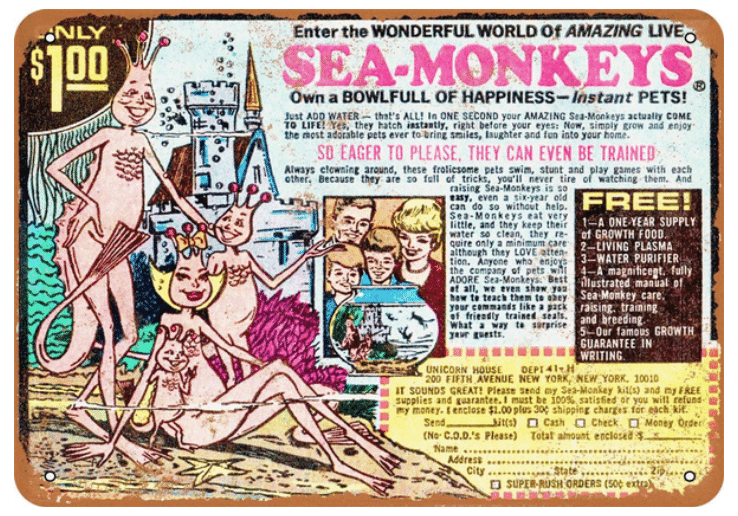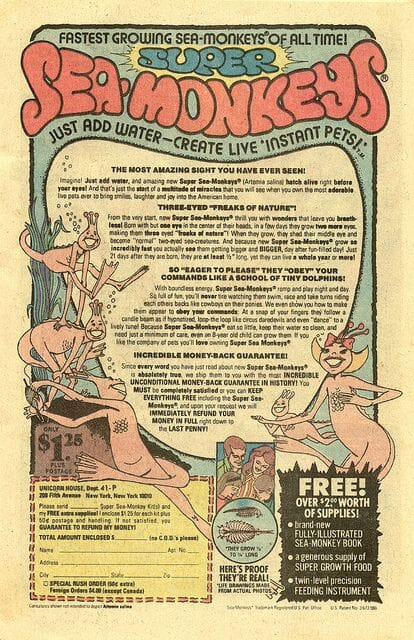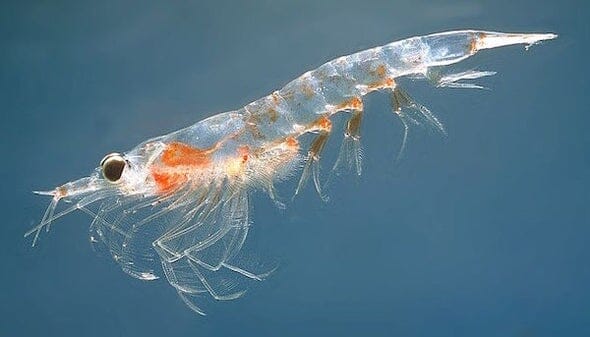Sea-Monkeys are a novelty aquarium pet, a type of brine shrimp that undergoes cryptobiosis.
Developed in the United States in 1957, by Harold von Braunhut, the shrimp are intended to be added to water, and almost always come bundled in a 3-pouch kit with other required pouches and instructions. Sometimes a small tank and/or supplementary pouches may also be included with the product. The product was heavily marketed in the 1960s and 70s, especially in comic books, and remains a presence in popular culture.
Another popular purchase through comic book advertisements in 1956 were ant farms.
Harold von Braunhut invented a brine-shrimp-based product in 1957.
Von Braunhut collaborated with a marine biologist, Dr. Anthony D'Agostino, to develop the proper mix of nutrients and chemicals in dry form that could be added to plain tap water to create an accommodating habitat for the shrimp to thrive. Von Braunhut was granted a patent for this process on July 4, 1972.
They were initially called "Instant Life" and sold for $0.49. But the inventor changed the name to "Sea-Monkeys" in 1962. The new name was based on their salt-water habitat, together with the supposed resemblance of the animals' tails to those of monkeys.
Sea-Monkeys were intensely marketed in comic books throughout the 1960s and early 1970s using illustrations by the comic-book illustrator Joe Orlando. These showed humanoid animals that bear no resemblance to the crustaceans. Many purchasers were disappointed by the dissimilarity and by the short lifespan of the animals.
Von Braunhut is quoted as stating: "I think I bought something like 3.2 million pages of comic book advertising a year. It worked beautifully."
The company that markets Sea-Monkeys today, Transience Corporation (not the same company that created them) continues to operate. That company's legal status was questioned during 4-year lawsuit originally filed on September 24, 2013, by Harold's widow, and against the company that is alleged to have illegally manufactured them, Big Time Toys.
Additionally, it was alleged that Big Time Toys breached their contract by not paying royalties for the rights to market the Sea Monkeys product. The company made their own from outside sources. On April 24 2017, it was ruled in a court that Transcience Corp. "failed to adequately show that she was the owner of the trademarks at the time the Complaint was filed." As such, the lawsuit has been dropped.
A colony of Sea Monkey's is started in this process:
- Add the contents of a packet labelled "Water Purifier" to a tank of water. This packet contains salt, water conditioner, and some brine shrimp eggs.
- After 24 hours, this is augmented with the contents of a packet labeled "Instant Life Eggs", containing more eggs, yeast, borax, soda, salt, some food and sometimes a dye.
- Shortly thereafter, Sea-Monkeys hatch from the eggs that were in the "Water Purifier" packet. "Growth Food" containing yeast and spirulina is then added every few days. The best temperature for hatching is 24–27 °C (75–81 °F). Extra and supplementary pouches can be purchased on the official website[15], though these aren't required for the well-being of the shrimp.
Biology - Two Artemia salina
The animals sold as Sea-Monkeys are claimed to be an artificial breed known as Artemia NYOS, formed by hybridising different species of Artemia. They are also claimed to live longer and grow bigger than ordinary brine shrimp; however, there are no references to these claims outside marketing material from the manufacturer. They undergo cryptobiosis or anhydrobiosis, a condition of apparent lifelessness which allows them to survive the desiccation of the temporary pools in which they live.
Space Travel
Astronaut John Glenn took Sea-Monkeys into space on October 29, 1998, aboard Space Shuttle Discovery during mission STS-95. After nine days in space, they were returned to Earth, and hatched eight weeks later apparently unaffected by their travels. However, earlier experiments on Apollo 16 and Apollo 17, where the eggs (along with other biological systems in a state of rest, such as spores, seeds and cysts) traveled to the Moon and back and were exposed to significant cosmic rays, observed a high sensitivity to cosmic radiation in the Artemia salina eggs; only 10% of the embryos which were induced to develop from eggs survived to adulthood. The most common mutations found during the developmental stages of the irradiated eggs were deformations of the abdomen or deformations on the swimming appendages and naupliar eye of the nauplius.

Comic book advertisement.

Advertisement from 1978. Super sized!

Read about sea monkeys and submarines at Scientific American magazine
